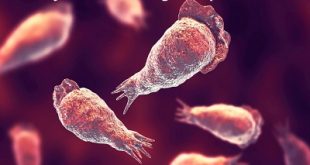Introduction
Pinworm Infection (Enterobrosis) is a benign intestinal disease caused by a short spindle-shaped worm 1/4 -1/2 inches long and whitish color. It may occur in both children and adults and usually infects the whole family. The adult worms reside in the colon of the host and the females deposit hundreds of eggs in the folds of anus usually at night.
Eggs of Pinworm on fecal float
E. vermicularis
How is pinworm infection spread?
- Pinworms are spread when an infected person, most often a child, has scratched his/her bare anal area and the eggs get under the fingernails.
- Pinworm eggs can be spread directly from contaminated hands or indirectly through contaminated clothing, bedding, food, or other articles.
- Pinworm eggs can survive for 2-3 weeks on clothing, bedding or other objects.
Discovery of Pinworm infection
The first evidence of pinworm infection dates back to Roman-occupied Egypt (30 BC-AD 395), and the oldest known pinworm ova have been found in human coprolites dating back to 7800 BC from Danger Cave, Utah. Pinworm has also been found to be referenced in the ancient writings of Hippocrates, dating back to 430 BC.
Ferreira et. al in 1997 and Hugot et. al in 1999 established pinworms as an example of an inherited parasite, meaning it is a host-specific parasite that has a long history of co-evolution with ancient human ancestors dating back to Africa before human dispersion across the continents.
Ancient pinworm finds have occurred in a variety of archaeological sites, and according to Goncalves et. al in 2002, the majority have been from coprolites from sites in the USA , with two from Chile and one each from Peru, Mexico, Germany, Denmark, and Argentina, as well as one finding from a Han dynasty mummy in China.
Epidemiology
E. vermicularis is the most common helminthic infestation in the United States. General prevalence in children is reported to be 0.2-20%. Pinworm infection is most common in persons who live in crowded living conditions and in individuals who are institutionalized. Prevalence in institutionalized persons is reported to be 50-100%. A similar prevalence of pinworm infestation has been reported in European countries.
The general prevalence of pinworm infection in some regions may be as high as 12%. Pinworm infection is most common in cosmopolitan areas in cool and temperate regions. Egg carrier rates vary by country, from 0.1-98.4%.
What causes pinworm infection?
Most people get infected by accidentally swallowing pinworm eggs. Anyone can get pinworms, but they are most common in school-aged children. They are usually spread like this:
- A child swallows pinworm eggs, and they travel to the child’s intestines. In about a month, the eggs hatch into worms. At night the female worms crawl out the rectum and lay eggs around the child’s anus.
- When the worms lay eggs, it can cause itching. If the child scratches, the eggs can cling to the child’s fingers and get stuck under the fingernails.
- The eggs then stick to things the child touches, such as clothing, dishes, toys, and furniture. The eggs can live 2 to 3 weeks outside the body.
- When you touch something the child has touched, the eggs get on your hands. Then if you touch food or your mouth, you can swallow the eggs. This starts the cycle over again.
- Pinworms spread easily in homes, day care centers, schools, and other places where groups of people spend time together. So if one person in your family has pinworms, others probably do too.
Who is at risk for a pinworm infection?
Pinworm infections affect people of all ages and geographical regions. Since the pinworm eggs are microscopic, it’s impossible to avoid infected individuals or areas.
While anyone can get a pinworm infection, the following groups are more susceptible:
- Children who attend day care, preschool, or elementary school
- Family members or caregivers of infected children and adults
- Individuals who live in institutions or other crowded accommodations
- Children or adults who don’t practice regular and careful hand-washing prior to eating
- 0Children who have a habit of sucking their thumbs
What are the symptoms of pinworms in children and adults?
If symptoms are present, they are similar in both children and adults. The signs and symptoms may include one or more of the following:
- Intense (pruritus) around the anus and/or vagina
- Discomfort in the anal and/or vaginal area
- Rash or skin irritation around the anus or vagina
Rashes on the buttocks area
- Insomnia or difficulty sleeping and/or restlessness due to irritation of skin
- Pinworms often can be seen on the anal skin or in the stools, sometimes detected in the vagina and may produce some vaginal discharge
Less common symptoms include:
- Abdominal pain
- Secondary bacterial infections from intense skin scratching
- Infrequent infection of the ureters and/or bladder may cause dysuria or bladder discomfort
- Many infected children and adults have few or no symptoms but, if the infection is heavy, the symptoms can be correspondingly more severe.
What are the consequences if pinworms aren’t treated?
Untreated pinworms may cause or have a role in causing:
- Diarrhea
- Significant malabsorption of food
- Weight loss
- Genital itching
- Bedwetting (enuresis)
- Main during urination (dysuria)
- Vaginal discharge which can be associated with genital skin irritation and rash
- Complications may include endometriosis, salpingitis, urethritis, urinary tract infection (UTI), vulvovagininitis, and possibly appendicitis.
How is a diagnosis of pinworm infection made?
Finding the female worm or the eggs confirms the diagnosis of pinworms. To find a female worm:
- At night, the adult worms can sometimes be seen directly around the anal area or in pajamas. The worm (one-quarter to one-half inch long) is clearly visible to the naked eye. Finding a worm confirms the diagnosis.
- If adult worms are not visible, conduct a tape test in the morning. Apply a piece of transparent tape against the folds of skin around the anus to pick up any eggs or worms. Seal in a plastic bag.
- Take the tape to a health care provider. The eggs and worms caught on the tape can be identified under a microscope.
- Pinworms are rarely spotted in stool samples. Because bathing or a bowel movement can remove the eggs, the tape test should be done as soon as the person wakes up in the morning.
What medicine treats pinworms?
Medication to get rid of pinworms include:
- Usually, a single tablet of mebendazole (Vermox) is used for treatment. This can sometimes be repeated a week later or, if infection persists, the medication is given again three weeks later.
- Pyrantel pamoate (Pin-Rid, Pin-X) is available over-the-counter for pinworm after confirmation of the diagnosis by a licensed healthcare practitioner. Drugs available over-the-counter vary from country to country. Pyrantel is the treatment of choice for pregnant women.
- To treat pinworms affecting urinary and genital organs, combination therapy with oral mebendazole (Vermox) and ivermectin (Stromectol) for the worms as well as topical therapy for the eggs may be required.
Pinworm infections can be cured; usually by 3 doses of medication, each 3 weeks apart. Individuals are encouraged to follow-up with their doctor to be sure treatment has been effective.
Natural or home remedies that treat pinworms
There are many natural and/or home remedies for pinworms although there is a lack of data to support claims. Some of the many suggested remedies include the following:
- Garlic
- Coconut (grated)
- Grapefruit seed extract and paste
- Grated carrots daily
- Onion juice 3 x per day for 2 days
- Pumpkin seeds
- Wormwood extract
The above are just a few of the remedies. Check with your doctors before using these remedies.
Prevention
Pinworm infections and reinfections can be diminished by the following:
- Make certain children wash their hands before meals and after using the restroom.
- Keep children’s fingernails trimmed.
- Discourage nail-biting and scratching the anal area.
- Have children change into a clean pair of underwear each day.
- Have children bathe in the morning to reduce egg contamination.
- Open bedroom blinds and curtains during the day as eggs are sensitive to sunlight.
- After each treatment, change night clothes, underwear, and bedding and wash them.
 Diseases Treatments Dictionary This is complete solution to read all diseases treatments Which covers Prevention, Causes, Symptoms, Medical Terms, Drugs, Prescription, Natural Remedies with cures and Treatments. Most of the common diseases were listed in names, split with categories.
Diseases Treatments Dictionary This is complete solution to read all diseases treatments Which covers Prevention, Causes, Symptoms, Medical Terms, Drugs, Prescription, Natural Remedies with cures and Treatments. Most of the common diseases were listed in names, split with categories.








apart from onions others doesn’t have dosages thanks for the good work done
This Knowledge about pinworm is very helpful for me to persuading a doctor about my product to prescribe . He raised a question about pin worm and I was unable to Ans him .Now I can Ans him confidently . Thanks for sharing knowledge .
thanks alot you remind me previos lesson,or usefull
This an encouraging article that reminds us of hygienic surrounding mostly washing our hands also our children hands ,thanks a lot.
Very useful tips about pinworm, thanks a lot
please am sick of body itching after bath please can I use the medicine mentioned above?it started almost 10 years now till date
Don’t use any medicine of your own because it may create some side effects unknowingly.Consult with dermatologist as soon as possible.
About the remedies to treat the pinworm,the onion juice to be precise ,does one apply it one the itchy part?
Thanks for the infor
Onion is taken as orally as a juice only. Onions contain sulfur naturally and this active ingredient is useful for fighting the pinworm infestation.
my anal area have been itching for about a year or more now what medication should I take please
Consult a doctor. Don’t use soaps or bathing lotion on that area frequently. Get help from an doctor as soon as possible.
Good evening?
I have the following signs and symptoms for a very long time.
– Serious movement of worm movement in my body
– Urinating on bed
– pain on my neck
– pain after sex @ my genetal region
– etc
Pls help explain to me.
I have visited various hospitals for test on culture and others. No positive results
Follow homeopathy treatment orw sidha treatment.
I have been suffering with pinworms now for about 5 years. GP treatment sparodic at first one or two mebendazole tablets 100mgeach then since about Dec 2015 another GPbegan to give me full courses of 6 tablets at 100mg each. But I still have some signs of infestation. I am a sev/disabled female with Lupus and Muscular Dystrophy and other accident damage and related conditions. But I may have been injected with affected contaminated needle by a hospital nurse.So from October 2014 I have had re-
can this disease be an STD?
Yes, the pinworm infection can also be transmitted during sexual contact.
what next if mebendazole does not cure pinworm?
The medications used for the treatment of pinworm are either mebendazole, pyrantel pamoate, or albendazole. Any of these drugs are given in one dose initially, and then another single dose of the same drug two weeks later.
How does diarrhea come about?
is it right to eat onion not juice to treat pinworm?
While there is anecdotal evidence suggesting that raw onion consumption may have some antiparasitic properties, it is not a proven or recommended treatment for pinworm infections. Consult with a healthcare professional for appropriate and evidence-based treatments for pinworms, which typically involve antiparasitic medications prescribed by a doctor. Dietary measures alone may not be sufficient for effective treatment.